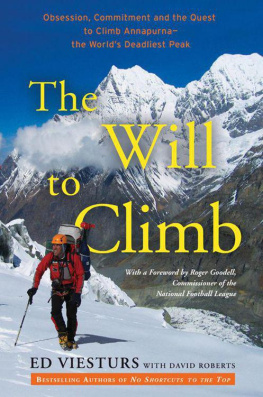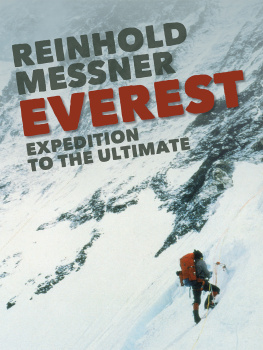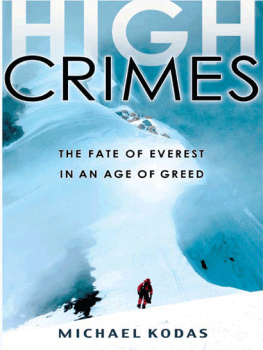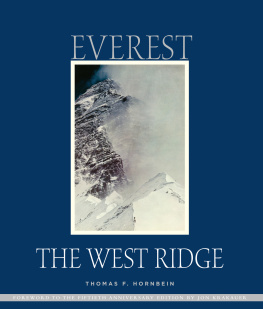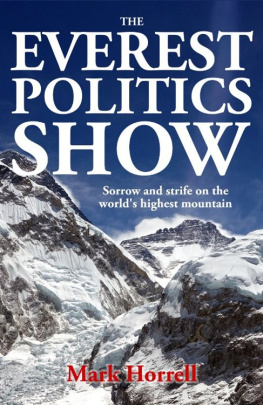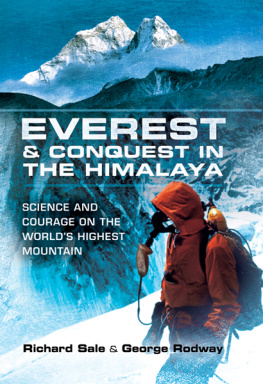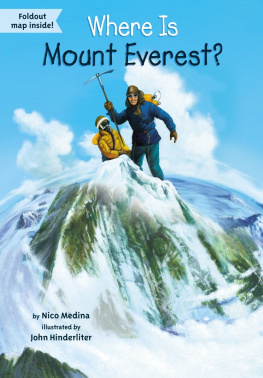Thank you for downloading this Touchstone eBook.
Join our mailing list and get updates on new releases, deals, bonus content and other great books from Touchstone and Simon & Schuster.
C LICK H ERE T O S IGN U P
or visit us online to sign up at
eBookNews.SimonandSchuster.com
Contents
This book is dedicated to the many friends with whom I have had the pleasure of experiencing the challenge of Everest on my eleven expeditions. In so many ways they all contributed to my success and survival.
Eric Simonson
George Dunn
Greg Wilson
Craig Van Hoy
Andy Politz
Jim Whittaker
Robert Link
Steve Gall
Kurt Papenfus
Hall Wendel
Wong Chu Sherpa
Carolyn Gunn
Rob Hall
Scott Fischer
Paula Viesturs
Jan Arnold
David Breashears
Robert Schauer
Araceli Segarra
Jamling Norgay
Guy Cotter
Veikka Gustafsson
Dave Carter
Jimmy Chin
Peter Whittaker
Also with great thanks to the many Sherpas, too numerous to list individually.
They are truly the unsung heroes of Everest.
Introduction
Ed Viesturs is fond of twofers. No, not two burgers, but still two for the price of one. Eds favored twofers are 8,000-meter peaks. A high altitude mountaineer has to have a big appetite just to savor one a season. But two? Well first, twofers nearly halve the cost. An even bigger advantage is being able to shuttle from peak one to peak two while already acclimatized and not too wasted from the first effort.
This book, The Mountain, offers other twofers. Though it speaks to us with Eds first-person voice, it has two authorsViesturs and Dave Robertstwo brains speaking through one mouth. Ed and Dave are friends. Both are climbers, though from different generations. Robertss profession has been as a writer and as a teacher of writing at Hampshire College. Over the course of three prior collaborations they have achieved a symbiosis in which the whole is more than the sum of the parts.
Another twofer in The Mountain: first is a rich and introspective account of Eds eleven Everest expeditions, integrated seamlessly within the broader context of his mountain journeys and of the rest of his life. The other part of this twofer is a concise, compelling account of the history of our human affair with the highest mountain on earth, from the discovery of Peak XVs height through early exploration to its first ascent in 1953 to the pioneering of new routes in new seasons and climbing in increasingly purer style.
Viesturs is best known as the first American to climb all fourteen of the 8,000-meter peaks. His quest was a tenacious sixteen-year commitment from Kangchenjunga in 1989 to Annapurna on his third attempt in 2005.
One cannot but wonder what enables a few determined human beings to accomplish such a feat. From the perspective both of a climber and a high altitude physiologist, I will speculate a bit on how Ed Viesturs and his select community of high-altitude wanderers manage to perform so well on 8,000-meter peaks without the use of supplemental oxygen. Are they a different beast from the average climber? In some ways, yes. In others, no.
One difference is evolution in style. A half-century ago, as members of the 1963 American Mount Everest Expedition, a few of us attempted a new route. Willi Unsoeld and I were indulging in brief bits of high-angle rock climbing on our summit day, with nearly forty pounds of oxygen cylinders as ballast in our Kelty packs. Our use of supplemental oxygen effectively lowered the physiologic altitude, which (presumably) more than offset the weight handicap. In his seminal essay Games Climbers Play, Lito Tejada-Flores posited the need for uncertainty in climbing (and hence motivation, as Dick Emerson, our West Ridge sociologist teammate, opined). In 1963 there was plenty of uncertainty to keep us motivated, but each such element pushes back the boundaries of the unknown. To keep the outcome in doubt means ramping up the rules of the game. In mountaineering, that change has been toward a simpler, lighter, faster style. One example: Messner and Habelers 1978 ascent of Everest without the use of supplemental oxygen represented a major paradigm shift in the style of high-altitude mountaineering. Of Eds seven successful ascents of Everest, he topped out on three occasions just breathing the air around him. (When with clients, Ed believes the guide should also use oxygen to optimize the well-being of the entire team.)
Another big change in climbing these high mountains is the amount of time and effort committed to the task. Our 1963 expedition was gone from home for nearly five months, more than twice the time involved in an Everest climb nowadays. I remember coming down from our traverse of Everest in1963 a tad tired and many pounds lighter. Part of the exhaustion was inherent in expedition-style climbing, which involved days and weeks of hanging out at high altitudes, humping loads, breaking trail, and putting in camps. In contrast, the current alpine style of light, fast ascents once one is acclimatized adds up to a lot less work and a lot less time spent physically and mentally deteriorating in the so-called Death Zone. Back then, mountain twofers were beyond imagination.
Are individuals like Ed Viesturs different physiologically from others? Perhaps. Over a decade ago, my colleague, Dr. Robert (Brownie) Schoene, a pulmonary and exercise doc at the University of Washington, put Viesturs through his paces on a treadmill, seeking an explanation for why Ed performs so well at extreme altitude. The findings? Eds maximum work capacity is on par with that of an endurance athletehis heart was able to deliver far more blood to exercising muscle than the average persons heart. But at extreme altitude, a person can only work at 2025 percent of his or her sea-level maximum; the hearts ability to pump far exceeds the demands placed upon it. More intriguing was Dr. Schoenes observation that Ed was able to perform sustained work at 85 percent of his maximum (VO2max); most mortals can manage only 5560 percent of their maximum. Whether this difference in work capacity helps explain his exceptional high-altitude performance is an intriguing question that has yet to be investigated.
Another critical factor that may help explain better performance at high altitude (or any altitude, for that matter) is efficiency, the ability to perform work at a lower oxygen cost. One can perceive this gift of efficiency in the seemingly effortless movement of the virtuoso long-distance runner. Studies to quantify the contribution of efficiency to performance are not easy to design, yet that capacity to get a bigger bang for the oxygen buck is likely one more factor that separates the Viesturs of the high mountain world from the average climber.
Although the physiology of exceptional human performance is intriguing, a lot of the story of such accomplishment comes from the mental side. Ed Viesturs began his high mountain quest one summit at a time. He found he was good at it, and his need for greater uncertainty morphed into his quest to climb all fourteen 8,000 meter peaks, and he wanted to do it without supplemental oxygen. His was not a unique goal. Reinhold Messner did it first, and Jerzy Kukuczka was not far behind. As I write, the 8,000-meter club is still pretty exclusive, numbering approximately 30 persons, only about half of whom, Ed among them, have climbed all fourteen without supplemental oxygen. In that, he emulated Messners style, and, like Messner, he imposed his own personal limit on the amount of risk he was willing to accept.
By the very nature of their activity, climbers are anything but risk averse, but they differ greatly among themselves on just how much risk is palatable. At one extreme are the adrenaline junkies or stimulus addicts, who, if their life is not on the thin edge, come away feeling unfulfilled. That group has a high mortality. The majority of committed climbers arent that extremefrom my perspective, Ed Viesturs had (and has) a lower tolerance than most for the prospect of dying on a mountain. To have the will to turn around a few hundred yards short of the summits of Everest and Shishapangma, or to part company with his climbing partners on Annapurna and descend because he didnt feel the conditions were right, bespeaks a perspective on life in which the climbing of a mountain is just a part. Thats often forgotten in the intensity of the moment. Perhaps out of all that Ed Viesturs has done in his climbing life, its this uncommon attribute that impresses me the most. If I examine my own past sins, Willi Unsoeld and I might well be accused of throwing caution to the winds on our West Ridge climb in 1963. True, back then, our feeling that this was a one-shot opportunity was part of the underpinning, but the tradeoff of a possibly shortened life simply did not intrude upon our thoughts. Ed seems different in the way he placed his passion into the context of life at large.
Next page

